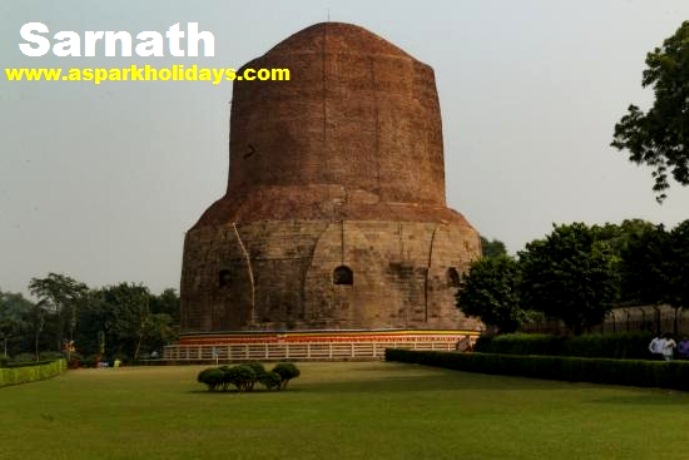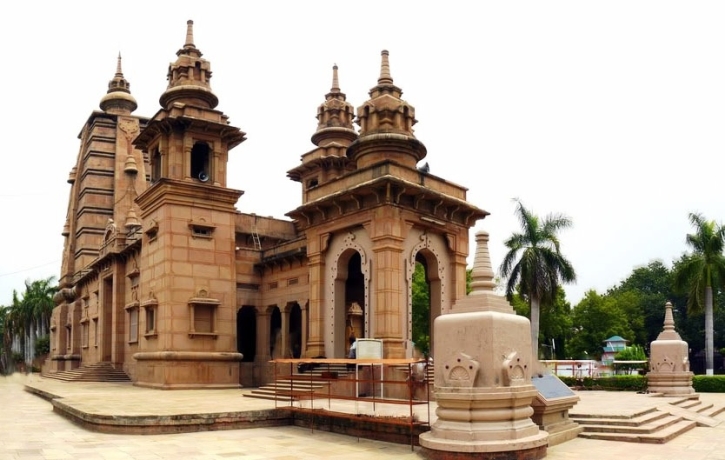
Sarnath has previously been known as Mrigadava, "deer park," and Isipatana, meaning the place where holy men (Pali: isi) fell to earth. The latter name is based in the legend that when the Buddha was born, devas came down to announce it to 500 holy men. The holy men all rose into the air and disappeared and their relics fell to the ground.
The current name Sarnath, from Saranganath, means "Lord of the Deer" and relates to another old Buddhist story in which the Bodhisattva is a deer and offers his life to a king instead of the doe he is planning to kill. The king is so moved that he creates the park as a sanctuary for deer.
History of Sarnath
After his enlightenment in Bodhgaya, the Buddha went to Sarnath seeking his five former companions. He found them, taught them what he had learned, and they also became enlightened. This event is referred to as "the turning of the wheel of the Dharma" and also marks the founding of the Sangha, or the community of monks.
Buddha's first discourse, delivered here at Sarnath, is known in Pali as the Dhammacakkhapavathana Sutta. Other Suttas include the Anattalakhana Sutta and the Saccavibhanga Sutta. The Buddha's central teaching after his enlightenment centered around the Four Noble Truths (concerning the meaning of life) and the Noble Eightfold Path (concerning the right way to live).
The Buddha spent the next rainy season in Sarnath at the Mulagandhakuti vihara. The Sangha having grown to 60 in number, the Buddha sent them out to teach the Dharma to others.
Buddhism flourished in Sarnath in part because of the support of kings and wealthy merchants based in nearby Varanasi. By the 3rd century Sarnath had become an important center for the arts, which reached its zenith during the Gupta period (4th-6th century AD). When Hsuan Tsang visited from China in the 7th century, he found 30 monasteries and 3000 monks living at Sarnath.
Sarnath became a major center of the Sammatiya school of Buddhism, one of the Nikaya or Hinayana schools. The presence of images of Heruka and Tara indicate that Vajrayana Buddhism was also practiced here.
At the end of the 12th century, Sarnath was sacked by Turkish Muslims. The site was subsequently plundered for building materials and has remained in ruins until the present day. The site was entirely deserted until 1836, when the British began excavations and restoration.
What to See at Sarnath
All of the ancient buildings and structures at Sarnath were damaged or destroyed by the Turks. However, amongst the ruins the Dharmekh Stupa is impressive at 128 feet high, and 93 in diameter. This dates from around 200 BC and is the spot where the Buddha is said to have preached his first sermon.
Only the foundations remain of the Dharmarajika Stupa, but it is notable as a rare pre-Ashokan stupa.
The decaying ruins of the Mulagandhakuti Vihara mark the place where the Buddha spent his first rainy season in meditation. In the 7th century, a writer described it as 200 feet high and containing 100 niches containing a Buddha carving along each wall. A life-sized statue shows the Buddha turning the wheel of the law.
To the east is the modern Mulagandhakuti Vihara with its beautiful wall paintings; behind it is the Deer Park, which is maintained as an open animal park and still attracts deer.
The Ashoka Pillar at Sarnath survived the Turkish invasion but was broken during excavations. The base still stands in its original spot and has some interesting carvings.
The splendid lion capital that topped the pillar, which thankfully survived its 45 foot drop to the ground is on display at the Sarnath Archaeological Museum. The museum also houses some of the greatest treasures of Indian Buddhist art, including almost 300 images.
There is also a Bodhi tree planted by Anagarika Dharmapala which was grown from a cutting of the Bodhi tree at Bodh Gaya. It is located next to a Sri Lankan monastery. Six national temples have been built by various Asian communities at Sarnath since the site's restoration, including a Tibetan temple and Sri Lankan temple.
Need Aspark Help?
For Tour Packages, Vehicle Rental and Customer Care Support.
+91 9999 31 7846
booking@asparkholidays.comWhy Travel with Us?

Excellent Support
Our Team Available 24x7 for Customer support
Best Price & Savings
We Offer the Most Competitive Prices.


